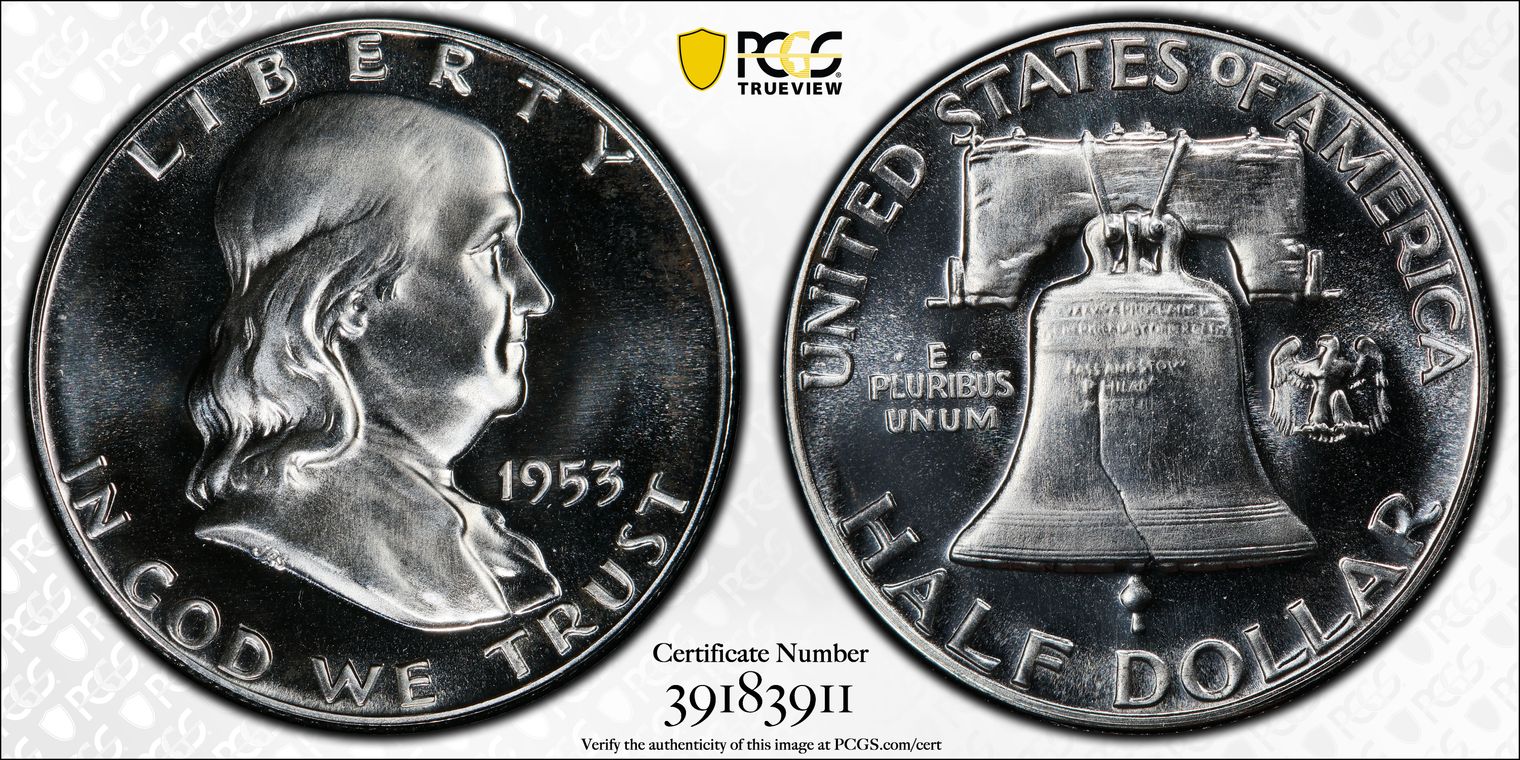1953 proof set question
 DollarAfterDollar
Posts: 3,215 ✭✭✭✭✭
DollarAfterDollar
Posts: 3,215 ✭✭✭✭✭
Is it possible that the half can be covered in fine hairlines from the mint? The box seems to be original and intact.
If you do what you always did, you get what you always got.
0
Comments
I've seen more re-packaged sets than impaired proof halves in sets.
bob
Seems unlikely. Are you looking at the coin through the cellophane envelope?
No, the coin was in the cello, The staple appeared original. Once out the lines were obvious. Die polish cant survive being struck twice, can it?
It may very well be die polish lines. The 1953 Franklin proof issue is known to have myriad die polish lines on some examples. Below is an example that I own and you may note there are strong vertical lines down Franklin's cheek on the obverse portrait as well as horizontal and diagonal lines through his forehead and receding hairline. On the reverse, there are a few more prominent die polish lines on the Liberty bell.
In honor of the memory of Cpl. Michael E. Thompson
Yes, in those days the mint refurbished Proof dies by repolishing them which resulted in hairline like marks. The difference is that they are raised, not into the coin as cleaning hairlines are. The trouble is they are just as distracting.
The other problem is a lot of Proof coins from this era have been cleaned. You have to be able to spot the difference.
This coin just has lines everywhere. In looking with 20 power glass I can see lines even in the recesses in the letters and numbers. I'm still confused but thanks for the help guys.
Sounds like die polish
All comments reflect the opinion of the author, even when irrefutably accurate.
The coins can have die polish covering the devices like others have said... But they can also be covered in hairlines right out of the boxes. From my experience most of these earlier Franklin Proofs are coming out of the package somewhere close to PF 65, which means there are many hairlines throughout the coin. It doesn't take much to scratch a Franklin Proof and when you're sitting in old packaging that's deteriorating around the coin it doesn't help.
Pictures?
As described above, determine if the 'lines' are raised or indented.... Either way, they can be distracting. Cheers, RickO
As noted above, it could be die polish, which is very common from that era, it may be hairlines. I occasionally see hairlines on coins in original packaging in 1950-64 proof sets. The mint, at least back then, was a production facility, not a clean room. lol
Agree with the comments above. Die polishing was common as seen on TomB's coin that he posted. I have some as well but you notice that there usually aren't too many die polish lines in the fields of proofs. Hairlines from cello bags were common as well.
A good photo sure would help.
The coin in question sounds like it has lines everywhere. To me, that probably rules out die polish because once the dies were repolished leaving lines everywhere, they were given a final polish which usually removed the lines from the fields. Visualize the die with the flat fields as the highest surface and the design incused into the face. The fields could easily have been polished and they normally were. This final polish did not touch the incuse devices. This is part of why cameos were produced off of repolished dies. If the fields were polished, then there wouldn't likely be lines in between letters.
Same with hairlines from the cello. These are usually on the high points and most visible in the mirrored fields. Again, it is unlikely that the cello would cause lines between the letters as the cello would bridge the gap between letters.
Without photos, I am thinking that the culprit is a planchet with a ton of marks on it. I've seen these occasionally on silver proofs, but not very often. What you see is a line heading toward a device like a letter and then stopping right at the base of the letter with no gap. Sorry I don't have a photo of this, that would be clearer.
Anyway, that is my two cents worth based on the verbal descriptions.
“In matters of style, swim with the current; in matters of principle, stand like a rock." - Thomas Jefferson
My digital cameo album 1950-64 Cameos - take a look!
Need photos but yes, it can very easily be die polish. Here is a PR67 example, look above and through the date, that is from the die and could easily be mistaken for surface hairlines. There are also wire brush marks visible in the devices.

https://images.pcgs.com/TrueView/39183911_large.jpg
This was removed from the set by me
Collector, occasional seller
Looks like die polish.
I took the coin to my local coin shop and got their input. They came to the conclusion that these were hairlines. They are fine but because no area of the coin was spared it was an easy call.
I've reviewed coins under a microscope concentrating on raised lines in the past and i just can't tell. I'm sure my brain is wired differently than most. My wife would agree.
Again, thanks for the input.
I suspect the Forum members are correct (i.e. die polish), not the dealer, in your case. I have never seen hairlines "in the recesses in the letters and numbers". That would be almost impossible to do. Get a second opinion, until then trust the Forum consensus.